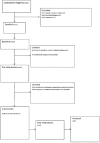Physical and Physiological Effects of Yoga for an Underserved Population with Chronic Low Back Pain
- PMID: 31543635
- PMCID: PMC6746048
- DOI: 10.4103/ijoy.IJOY_78_18
Physical and Physiological Effects of Yoga for an Underserved Population with Chronic Low Back Pain
Abstract
Background: Yoga has been shown useful in reducing chronic low back pain (CLBP) through largely unknown mechanisms. The aim of this pilot study is to investigate the feasibility of providing yoga intervention to a predominantly underserved population and explore the potential mechanisms underlying yoga intervention in improving CLBP pain.
Methods: The quasi-experimental within-subject wait-listed crossover design targeted the recruitment of low-income participants who received twice-weekly group yoga for 12 weeks, following 6-12 weeks of no intervention. Outcome measures were taken at baseline, preintervention (6-12 weeks following baseline), and then postintervention. Outcome measures included pain, disability, core strength, flexibility, and plasma tumor necrosis factor (TNF)-α protein levels. Outcomes measures were analyzed by one-way ANOVA and paired one-tailed t-tests.
Results: Eight patients completed the intervention. Significant improvements in pain scores measured over time were supported by the significant improvement in pre- and post-yoga session pain scores. Significant improvements were also seen in the Oswestry Disability Questionnaire scores, spinal and hip flexor flexibility, and strength of core muscles following yoga. Six participants saw a 28.6%-100% reduction of TNF-α plasma protein levels after yoga, while one showed an 82.4% increase. Two participants had no detectable levels to begin with. Brain imaging analysis shows interesting increases in N-acetylaspartate in the dorsolateral prefrontal cortex and thalamus.
Conclusion: Yoga appears effective in reducing pain and disability in a low-income CLBP population and in part works by increasing flexibility and core strength. Changes in TNF-α protein levels should be further investigated for its influence on pain pathways.
Keywords: Brain imaging; chronic low back pain; core strength; flexibility; tumor necrosis factor-α; yoga.
Conflict of interest statement
There are no conflicts of interest.
Figures





Similar articles
-
Yoga compared to non-exercise or physical therapy exercise on pain, disability, and quality of life for patients with chronic low back pain: A systematic review and meta-analysis of randomized controlled trials.PLoS One. 2020 Sep 1;15(9):e0238544. doi: 10.1371/journal.pone.0238544. eCollection 2020. PLoS One. 2020. PMID: 32870936 Free PMC article.
-
Effect of short-term intensive yoga program on pain, functional disability and spinal flexibility in chronic low back pain: a randomized control study.J Altern Complement Med. 2008 Jul;14(6):637-44. doi: 10.1089/acm.2007.0815. J Altern Complement Med. 2008. PMID: 18673078 Clinical Trial.
-
The impact of modified Hatha yoga on chronic low back pain: a pilot study.Altern Ther Health Med. 2004 Mar-Apr;10(2):56-9. Altern Ther Health Med. 2004. PMID: 15055095 Clinical Trial.
-
Participant Characteristics Associated with Symptomatic Improvement from Yoga for Chronic Low Back Pain.J Yoga Phys Ther. 2014 Jan 11;4(1):151. doi: 10.4172/2157-7595.1000151. J Yoga Phys Ther. 2014. PMID: 25401042 Free PMC article.
-
Yoga for chronic low back pain: a meta-analysis of randomized controlled trials.Pain Res Manag. 2013 Sep-Oct;18(5):267-72. doi: 10.1155/2013/105919. Epub 2013 Jul 26. Pain Res Manag. 2013. PMID: 23894731 Free PMC article. Review.
Cited by
-
Adverse events in India's Ayush interventions for cervical and lumbar spondylosis: a systematic review.Eur J Med Res. 2024 Jul 31;29(1):396. doi: 10.1186/s40001-024-01985-3. Eur J Med Res. 2024. PMID: 39085970 Free PMC article.
-
Role of Yoga in Minimizing Stress and Anxiety in Women Experiencing Dysmenorrhea.J Lifestyle Med. 2023 Aug 31;13(2):90-96. doi: 10.15280/jlm.2023.13.2.90. J Lifestyle Med. 2023. PMID: 37970322 Free PMC article. Review.
-
Vibrating Exercise Equipment in Middle-Age and Older Women with Chronic Low Back Pain and Effects on Bioelectrical Activity, Range of Motion and Pain Intensity: A Randomized, Single-Blinded Sham Intervention Study.Biology (Basel). 2022 Feb 8;11(2):268. doi: 10.3390/biology11020268. Biology (Basel). 2022. PMID: 35205134 Free PMC article.
-
Yoga compared to non-exercise or physical therapy exercise on pain, disability, and quality of life for patients with chronic low back pain: A systematic review and meta-analysis of randomized controlled trials.PLoS One. 2020 Sep 1;15(9):e0238544. doi: 10.1371/journal.pone.0238544. eCollection 2020. PLoS One. 2020. PMID: 32870936 Free PMC article.
-
Potential Role of Yoga Intervention in the Management of Chronic Non-malignant Pain.Evid Based Complement Alternat Med. 2022 May 28;2022:5448671. doi: 10.1155/2022/5448671. eCollection 2022. Evid Based Complement Alternat Med. 2022. PMID: 35668780 Free PMC article. Review.
References
-
- Katz JN. Lumbar disc disorders and low-back pain: Socioeconomic factors and consequences. J Bone Joint Surg Am. 2006;88(Suppl 2):21–4. - PubMed
-
- Manchikanti L, Singh V, Falco FJ, Benyamin RM, Hirsch JA. Epidemiology of low back pain in adults. Neuromodulation. 2014;17(Suppl 2):3–10. - PubMed
-
- Karppinen J, Shen FH, Luk KD, Andersson GB, Cheung KM, Samartzis D. Management of degenerative disk disease and chronic low back pain. Orthop Clin North Am. 2011;42:513–28, viii. - PubMed
-
- Swinkels-Meewisse IE, Roelofs J, Verbeek AL, Oostendorp RA, Vlaeyen JW. Fear of movement/(re) injury, disability and participation in acute low back pain. Pain. 2003;105:371–9. - PubMed
-
- Vlaeyen JW, Seelen HA, Peters M, de Jong P, Aretz E, Beisiegel E, et al. Fear of movement/(re) injury and muscular reactivity in chronic low back pain patients: An experimental investigation. Pain. 1999;82:297–304. - PubMed
LinkOut - more resources
Full Text Sources
